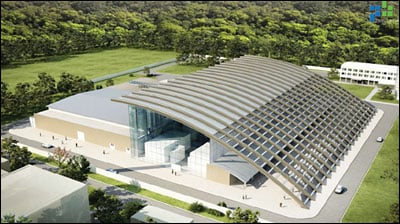
EU Invests in Romania’s Nuclear Photonics Project
BRUSSELS, Sept. 19, 2012 — The European Commission approved on Tuesday nearly €180 million ($235 million) for a new laboratory in Romania that will study laser-based nuclear physics.
The funding for Extreme Light Infrastructure - Nuclear Physics (ELI-NP) will be provided as part of a broader initiative with the Czech Republic and Hungary to form a pioneering European research consortium. ELI-NP is expected to involve 40 research and academic institutions from 13 member states as well as members of the business sector. It is expected to be part of the first pan-European multidisciplinary network to host the most intense lasers available.

Proposed design of the Extreme Light Infrastructure-Nuclear Physics (ELI-NP) facility. The European Commission has approved nearly $235 million in funds for the new laboratory in Romania that will study laser-based nuclear physics. (Image: ELI-NP)
"This is exactly the type of project we want to see more of in the future. It is aimed at boosting research and innovation with a clear EU added value, to ensure that each and every euro is wisely spent," said Commissioner for Regional Policy Johannes Hahn.
The ELI-NP, to be built in Magurele, south of Bucharest, will consist of two major components, a very high intensity laser constructed by combining the beams of two 10-petawatt Apollon-type lasers, and a high-intensity beam generated by combining laser light with an electron beam created by a linear accelerator. It is expected to be operational in 2015.
Research at the facility will be done in fundamental and nuclear physics, astrophysics, and material science and the life sciences. Researchers are also expected to work on new ways to handle nuclear materials and radioactive waste. ELI-NP is one part of the Extreme Light Infrastructure (ELI), which was identified in 2006 by the European Strategy Forum on Research Infrastructure as one of the top-priority projects of research infrastructure for Europe.
The project is the second pillar of a pan-European laser facility; the commission approved €236 million in funding for the first ELI pillar (ELI-Beamlines) in the Czech Republic in April 2011. The third pillar, ELI-Attosecond, is planned for Hungary and will be dedicated to extremely fast dynamics by taking snapshots on the attosecond scale of the electron dynamics in atoms, molecules, plasmas and solids. It will also pursue ultrahigh-intensity laser research.
ELI-NP is expected to give a much-needed boost to research and development in Romania, helping the country to bridge the innovation gap and foster knowledge and technology transfer, officials said. Currently the country invests only about 0.5 percent of its GDP annually across the public and private sectors. It has a Europe 2020 target of 2 percent as part of a broader EU-wide target of 3 percent.
"We have very high hopes for the ELI-NP project. Through it, Romania has a chance to put itself firmly on the map of European research, to retain highly specialized workers - reversing the 'brain drain' and attracting new companies to the region," Hahn said.
The EU's financial investment is being made through the Increase of Economic Competitiveness program of the European Regional Development Fund (ERDF). Tuesday's decision approves the ERDF contribution for the first phase of ELI-NP, from 2011-2015, while the total cost of the project amounts to €356.2 million (about $465 million).
For more information, visit: www.eli-np.ro
Published: September 2012